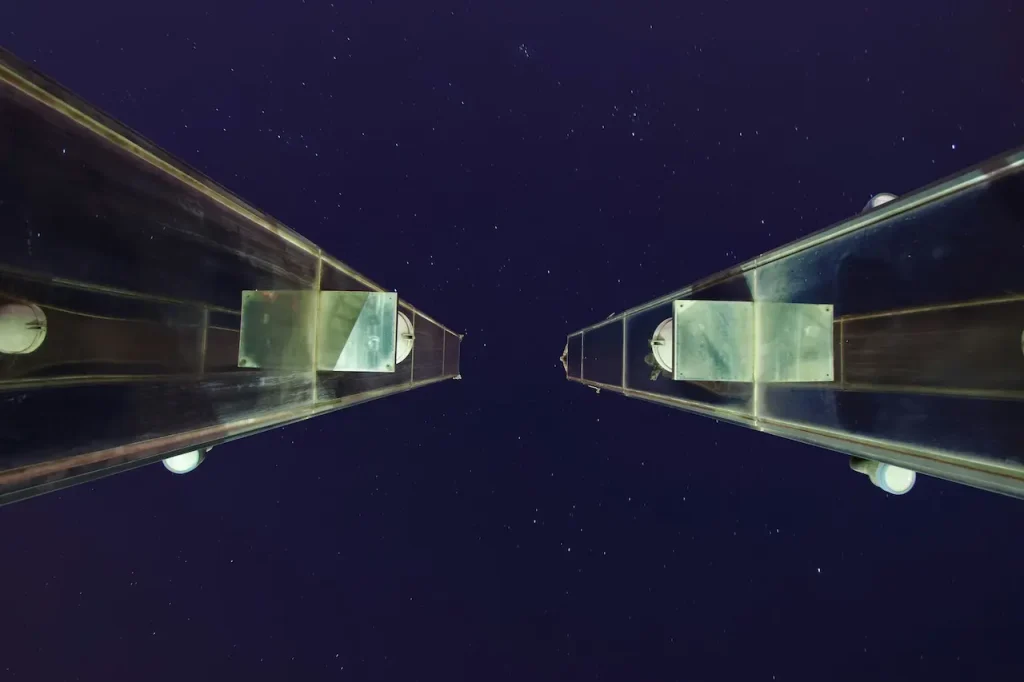Imagine yourself standing at the edge of the Atlantic coast of Ireland, with the spray of the sea misting your face. You can taste and smell the briny air, you can hear the seabirds’ cries, and you can even smell the salt. Here, on the edge of what we can see and what is beyond, the idea of a parallel universe becomes more than an abstract concept. It suddenly pulsates with possibilities.
1. What are parallel universes?
The concept of parallel worlds, or “multiverse theory”, is a reflection of the infinite variations of our universe. From quantum physicists and cosmologists to other scientists, they all ponder the idea that our universe isn’t unique. Our reality could be just one of many “branches” with their own rules and history.
Imagine being in Cebu City in the Philippines, a vibrant port city glistening in the tropical sunshine, with its bustling streets, pandan-sweet restaurants, and Barangay Markets awash in neon fruit skies at sunset. Imagine stepping through a door to a parallel Cebu, where you’ll find the same city but with a futuristic skytrain, or a sea that isn’t turquoise, but violet, or Hello Kitty as the official mascot for every barangay festival. It’s a strange twist in geography and time that makes the familiar seem unfamiliar.

It’s not fantasy, but a way that scientists describe the possibilities. The “many-worlds” interpretation of quantum mechanics suggests that when a quantum event can have multiple outcomes, such as a spinning electric current collapsing to “up” and “down”, the universe is split into different branches. The universe is a tree, and our reality is a branch.
Cosmologists imagine bubble universes (space and time bubbles) floating in a foamy cosmic liquid, like soap bubbles colliding or drifting. Each bubble has its physics and constants and may even have a different dimension. This idea is so expansive that it changes our perception of “everywhere.”
2. Can We Visit Them Someday?
Imagine the sea-air shimmering on that rocky promontory at Moher. Was it a portal or a mirage, too? Were we able to cross over from familiar ground into another reality, while perched?
At the moment, no. The idea of travelling to a parallel world remains in the realms of theory. The current state of physics does not allow for a working “doorway,” but that hasn’t stopped dreamers from sketching one.
In speculative theory, wormholes are Einstein-Rosen Bridges that suggest tunnels in the fabric of spacetime. We could travel great distances, or even enter a different branch of reality, if we were able to engineer wormholes. Some theories claim that hidden dimensions could be revealed by gravitational fields, or that quantum entanglement in technicolour could indicate the existence of another universe. All of these theories has not been tested and may be years or eons away from being put into practice.
In our imaginations, we follow such paths constantly. Imagine stepping into the wardrobe of C.S. Lewis’ The Chronicles of Narnia or stepping into Platform 9 1/4 at King’s Cross to find a Hogwarts Express. These stories do more than just entertain. They show how the idea of a parallel universe sparks wonder when it remaps our familiar geography onto something new and startling. It may not be a real journey, but it will give you the same feeling: the creak as you enter a portal, the smell of the unknown and the heartbeat.
3. What might they look like?
We’ll return to Cebu and explore the “other side,” assuming we can get there. Imagine yourself walking down the streets of Colon Street in the Philippines. It is the oldest street, and it’s filled with jeepneys. sari-sari shops, and mango-sweet conversations. Imagine it now:
- Cebu – Neon Rain: Version where electric monorails glide across the streets. Neon lights illuminate the skyline. While street vendors continue to sell “danggit”, “lechon” and puto, robotic carts are now delivering matcha puto. A blend of old-fashioned and modern, the aroma of roasted meats and ozone is mingled with sea breeze and ozone.
- Cebu – Underwater City: A universe where rising waters transformed the coastline centuries before. Cebu has become a city with submerged temples and canals. Bangkas, coral-encrusted boats, glide by, while schools and jeepneys painted brightly drift past. This version is a mix of geography and state of mind, with water as the ceiling.
- Cebu – Highland Plateau Imagine Cebu split up into mountainous plateaus by tectonic movements. The central plaza looks out over the valley gardens of orchids and coffee. The rest of the world is far away. Airships are used by traders to arrive. The air is crisp and scented with wild flowers, yet you are still in your hometown.
These versions show how geography can shape a story and how a parallel universe can be intimate as well as bizarre. The street layout and skyline are familiar, but the patterns have been twisted into a dream logic geography that is just out of reach.

4. Who or what would we meet?
Who would we find if we stepped into an alternate Cebus, or alternate Earths? Let’s get imaginative.
- A Mirror-You: Maybe you’ve met yourself–but not quite. In one universe, you are an oceanographer who studies coral-coral grow canals. In another, you are a chef creating a marinade from volcanic ash. And in yet another, you weave kulintang with electronic ambient. It would be strange to meet that self–same laugh, same eyes, but different choices in your life map.
- Extra Earthly Flora and Fauna: Maybe a parallel Earth has evolved different species. In one version of the story, Cebu’s waters are teeming with not only sardines, but also phosphorescent creatures glowing in hypnotic colours. Sky-kites, which are bird-like creatures that fly between islands to carry messages, may share the road with jeepneys. Sea, sky and land are all alive with different forms of life.
- Humans with Different Histories. You may encounter people who have a dramatic difference in their ancestry. Their language, politics and culture could also be different. In Cebu, humans may speak a mix of Visayan with an invented language. History classes have carved out different stories in every barrio. Religion, cuisine, and urban planning all follow new veins. Each mural, each laugh, and every greeting felt foreign and strangely resonant as you walked down the street.
- Posthuman or Hybrid Entities: Imagine a world in which humans have merged with machines and evolved into bio-ships. They may also be symbiotically integrated with nature. You may meet beings that sleep in coral towers and whose skin photosynthesises. Or creatures who were born underwater and breathed through gilded lungs. They would be you, but not you – familiar in kindness but alien by essence.
It would be like coming home and seeing yourself in rippled glasses. Kind, yes, but it’s the refracted image. You would recognise their voice and gestures and feel both the connection and the disconnection.
5. Landscapes of the mind: How geography meets the multiverse
Writing about parallel universes in this way, rooted in geography, has the magic of tying big cosmic ideas with places we already know. They give us anchors. A cliff or a river, or a plaza. We can imagine a different version of the place we have felt, smelt, and heard. This movement from the concrete into the speculative is deeply human. We start in comfort and then tip ourselves to the strange.
Let me take you through some hypothetical vignettes. Each one is based on a real or imagined place that echoes a familiar experience.
Vignette A: Midnight in Reykjavik – Auroras of the mind
You are standing on an icy beach outside of Reykjavik in Iceland. The northern lights shimmer in ribbons of green, purple and blue. In a parallel universe, auroras are not flickering, but roads. Each streak leads to a companion world. You might find yourself in a world where Iceland is always warm, with forests covering the lava and glaciers dripping with mineral waterfalls. What if light weren’t just an astronomical display but also a frontier?
Vignette B: Dawn on the Great Rift Valley – Echoes of Time
The dawn light is illuminating the arid deserts and ancient sediments near Lake Turkana, Kenya. Here, you can feel the prehistory of humans – your first ancestors are emerging. In another branch of this deep past, perhaps humans never left Africa. Here, the language is a tonal one, like birdsong. The housing is made of volcanic rock and encrusted with lichens that glow at night. Your ancestors are walking with you in whispered memories. The parallel in geography is not elsewhere, but before.
Vignette C: Rain in Amazonia – Green Mirrors
You are under a canopy of trees in the Amazon rainforest. Rain drums. Life pulses. What if in another universe, the forest didn’t lose vast areas to deforestation? Instead, the Amazon would grow into vertical sky-trees that formed green towers. A living city of flora, fauna, and flora. What would happen to our relationship with the planet if jungles became bridges and not frontiers? Here, the forest isn’t just carbon — it’s symbiotic and a fellow civilisation.
6. Why does it matter?
Why invest in such imagination? Why create such worlds from Cebu or Iceland, or the Rift Valley? Parallel-universe thinking is more than just entertainment. It sharpens the understanding of our world’s fragility and of its stories.
- Giving the abstract emotional texture: We give them emotional depth by tying cosmic concepts to real-world places. Parallel universes are less like news headlines and more like travel journals.
- Empathy: Imagine meeting people who are different from you or other communities. It helps us to develop empathy by letting us know that our past, our environment and our culture are not predetermined.
- Encouraging stewardship: Real landscapes–forests, rivers, cities–become stages for alternate stories. We are reminded of the importance of caring for our places when we can see them flourishing differently.
- Travel is a source of creativity. The thought of exploring the unknown, or into variations of our world, inspires wonder and curiosity. It also drives innovation and creativity.

Two Planets on Different Sides
7. Last Thoughts on Navigation
Let’s end at the same place we started–at the cliff edge, with wind on your cheeks and salt in your lungs. This spot is the boundary between familiarity and infinity, not between land and ocean. For now, parallel universes are out of reach. But the act of imagining these worlds – walking their streets, breathing a new sky, and sharing your city with someone who you almost recognise – is itself a kind of travel. This is a journey that’s as vivid and as real as any long flight or road trip, guided by empathy, curiosity, love of place, not GPS or maps.
Next time you’re in a store, a forest or watching a sunset, ask yourself: Could this moment have unfolded differently if it had been rewritten? What colours would it have? What would it feel like to breathe? You may only be imagining the portal, but for a moment, you are there.




